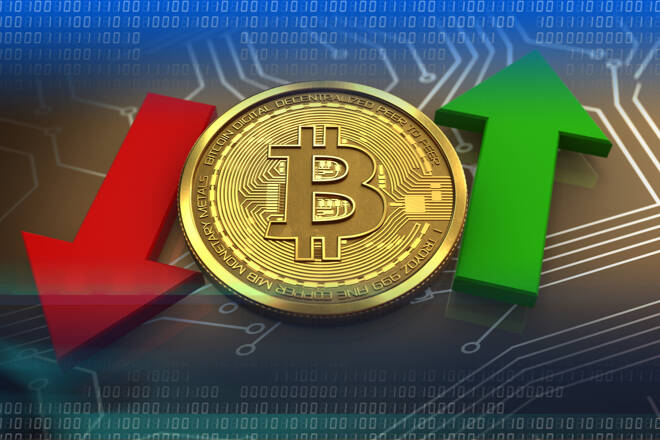Advertisement
Advertisement
BTC Fear & Greed Index Stays Greedy Signaling a BTC Return to $25,000
By:
It was a bearish Thursday session for BTC, with Fed Fear weighing. However, easing regulatory risk limited the downside for the Fear & Greed Index.
In this article:
Key Insights:
- It was a bearish Thursday, with BTC falling by 3.24% to end the day at $23,529.
- Fed Fear replaced SEC and regulatory jitters to send BTC and the broader crypto market into the red.
- The Fear & Greed Index remained within the Neutral zone despite the bearish session, falling from 62/100 to 61/100.
On Thursday, bitcoin (BTC) fell by 3.24%. Partially reversing a 9.95% rally from Wednesday, BTC ended the day at $23,529. Despite the bearish session, BTC revisited $25,000 levels for the first time since August.
After a range-bound morning, BTC rose to an early afternoon high of $25,234 before hitting reverse. BTC broke through the First Major Resistance Level (R1) at $25,113 before sliding to a final-hour low of $23,526. Steering clear of the First Major Support Level (S1) at $22,802, BTC ended the day at $23,529.
Fed Fear Overshadows Easing Regulatory Risk Jitters
Following a volatile 10-days, which saw the SEC target crypto staking through Kraken and stablecoins through Binance USD (BUSD), investor focus turned to the Fed on Thursday.
In the afternoon session, US wholesale inflation and jobless claims figures drew investor interest.
In January, the US wholesale annual inflation rate softened from 6.5% to 6.0% versus a forecasted 5.4%. While inflationary pressures have eased, inflation remains well above the Fed’s target, raising fears of a more prolonged period of interest rate hikes to tackle inflation.
Jobless claims also supported a more hawkish Fed policy outlook. Initial jobless claims slipped from 195k to 194k versus a forecasted rise to 200k. Sub-200k reflects a tight labor market. With the US unemployment rate at 3.4%, the Fed has plenty of wriggle room to curb inflationary pressures aggressively.
Fed chatter added to the bearish mood. FOMC member Loretta Mester said she is open to more aggressive rate hikes than her colleagues had proposed in February, noting that inflation remained too high. James Bullard talked about continued rate increases to maintain the softer inflation trend.
Despite increased SEC activity in the digital asset space, news of the SEC charging Terra Labs and founder Do Kwon for fraud had a muted impact on investor sentiment. The SEC charged Terra Labs and Do Kwon for defrauding investors on Thursday.
The Day Ahead
Following the Thursday reversal, we expect continued investor sensitivity to hawkish Fed chatter. FMOC members talking about more aggressive interest rate hikes to tackle inflation would weigh on BTC and the broader crypto market.
However, we expect regulatory activity and US lawmaker chatter to have more influence on investor sentiment. Investors should also continue monitoring the crypto news wires for FTX, Genesis, and Silvergate Bank updates.
A lack of material news will likely leave BTC in the hands of the NASDAQ Composite Index. On Thursday, the NASDAQ Composite Index fell by 1.78%, with the NASDAQ mini down 57 points this morning.
The Fear & Greed Index Remains in the Greed Zone Despite Fed Fear
Today, the BTC Fear & Greed Index showed a muted response to a bearish BTC session. The Index remained within the Greed zone, falling from 62/100 to 61/100. The modest decline reflected investor resilience to Fed Fear, with regulatory risk likely to have greater significance.
This week, easing regulatory jitters and US lawmaker support have returned the Index to the Greed zone. With investors anticipating the Fed to push interest rates above 5%, FOMC members would need to signal a possible interest rate peak at 5.50% to send the Index into the Fear zone.
After returning to the Greed zone, the Index must avoid the Neutral zone to support a BTC return to $25,000. However, an Index return to the Fear zone would signal a near-term bullish trend reversal.
SEC activity and US lawmaker chatter will remain the key drivers over the near term.
Bitcoin (BTC) Price Action
At the time of writing, BTC was down 0.35% to $23,446. A mixed start to the day saw BTC rise to an early high of $23,551 before falling to a low of $23,350.
Technical Indicators
BTC needs to move through the $24,096 pivot to target the First Major Resistance Level (R1) at $24,667 and the Thursday high of $25,234. A return to $25,000 would signal a breakout session. The crypto news wires need to be crypto-friendly to support an extended rally.
In the event of an extended rally, BTC would likely test the Second Major Resistance Level (R2) at $25,804 and resistance at $27,000. The Third Major Resistance Level (R3) sits at $27,512.
Failure to move through the pivot would leave the First Major Support Level (S1) at $22,959 in play. However, barring another risk-off-fueled crypto sell-off, BTC should avoid sub-$22,500 and the Second Major Support Level (S2) at $22,388.
Looking at the EMAs and the 4-hourly candlestick chart (below), it was a bullish signal. BTC sat above the 50-day EMA ($22,826). The 50-day EMA pulled away from the 100-day EMA, with the 100-day EMA widening from the 200-day EMA, delivering bullish signals.
A hold above S1 ($22,959) and the 50-day EMA ($22,826) would support a breakout from R1 ($24,667) to target R2 ($25,804) and $27,000. However, a fall through S1 ($22,959) and 50-day EMA ($22,826) would give the bears a run at the 100-day EMA ($22,643) and S2 ($22,388). A fall through the 50-day EMA would send a bearish signal.
About the Author
Bob Masonauthor
With over 20 years of experience in the finance industry, Bob has been managing regional teams across Europe and Asia and focusing on analytics across both corporate and financial institutions. Currently he is covering developments relating to the financial markets, including currencies, commodities, alternative asset classes, and global equities.
Latest news and analysis
Advertisement
